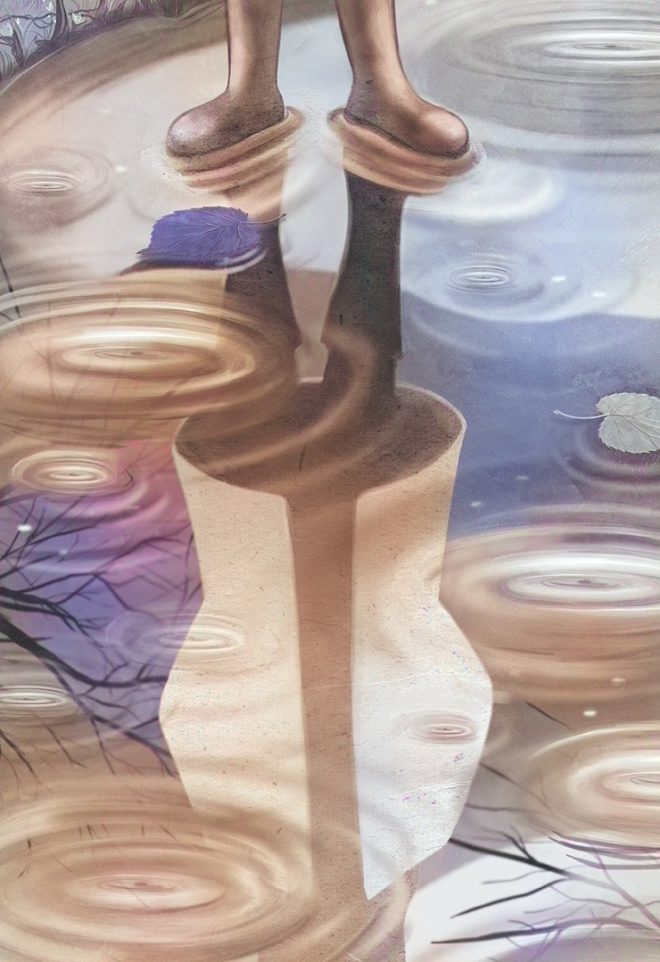
In the time of silver rain
The earth puts forth new life again
—Langston Hughes
Scientists—who have a tendency to stomp the poetry out of any experience—now know what makes the garden smell so luscious after a rain. That aromatic earthy smell has been known since 1964 as petrichor, from the Greek petros (rock) and ichor (blood of the gods), a linguistic invention of Australian chemists Isabel Bear and Richard Thomas. This may not be the catchiest of names, but—I think we can all agree—it’s still a great improvement over Bear and Thomas’s first try, which was “argillaceous odor.”
Petrichor, scientists tell us, has been around for at least 500 million years—so if you want a good guess as to what the earth smelled like to the dinosaurs, nip outside after a Spring rainfall and take a deep sniff. That’s petrichor: the wonderful smell of green stuff and good rich dirt. And, based on a lot of recent research, we now know just what causes it and why.
The main component of petrichor is a compound called geosmin which, chemists helpfully tell us, is a bicyclic terpene. It’s produced by soil bacteria—notably Streptomyces bacteria, an enormous genus of 500 or more species, a few of which produce anticancer drugs, antifungal agents, and literally dozens of antibiotics which have cured us of everything from conjunctivitis to cholera, tuberculosis, and plague. All of the Streptomyces also make geosmin.
And they make it, it turns out, because of springtails.
Springtails are tiny pinhead-sized bugs that are ubiquitous in soil; you’re doubtless harboring millions of them at this very moment in your backyard compost heap. They’re named for a pogo-stick-like organ on their abdomens which, when released, shoots them into the air. This sounds quite fun and they apparently do this often enough that, collectively, springtails are nicknamed “jumping dirt.” They’ve also got a passion for the scrumptious scent of geosmin—and, incidentally, for the bacteria that produce it, which are a favorite springtail food.
While a biochemical signal that broadcasts “Come eat me!” hardly seems a recipe for survival, the geosmin-generating Streptomyces are actually onto a good thing. Munching springtails are essential for disseminating Streptomyces spores. The spores either trek through the springtails’ digestive tracts, eventually emerging as tiny springtail plops, or stick to their backs—either way eventually moving to new territory and ensuring the continued propagation of Strepomyces colonies. It’s a tiny-sized version of fruit- and berry-gobbling birds spreading undigested seeds across the landscape to produce even more fruits and berries.
Springtails aren’t the only creatures who are attracted by a whiff of geosmin. Camels, who can zero in on oases up to 50 miles away by tracking the scent of geosmin in distant damp earth. We’re no slouches when it comes to geosmin, either. People can sense geosmin at quantities as tiny as 100 parts per trillion. In other words, we’re about 10,000 times more sensitive to geosmin than sharks are to blood.
This isn’t always a good thing.
Take the case of beets.
Beets never rate high on most favored vegetable lists. In fact, they’re generally at rock bottom, along with turnips and Brussels sprouts. (The most popular veggies, almost invariably, are tomatoes, corn, potatoes, and carrots.) People generally don’t like turnips and Brussels sprouts because of their content of bitter-tasting chemicals. These don’t bother some of us, but others are genetically disposed to be abnormally sensitive to them—which means if you’re spurning the sprouts at a holiday dinner, go ahead and blame your genes. Dislike of beets, on the other hand, seems to stem from the fact that they taste like dirt.
And they do taste like dirt. The lush earthy flavor of beets is due to geosmin—in part picked up from geosmin-producing soil bacteria and in part, at least some recent research indicates, made by beets on their own. Many beet-eaters find this delicious—me, for example; I save my vegetable spurning for lima beans—but a touch of mud flavor clearly isn’t everybody’s cup of tea. Too much geosmin can make filets of bottom-feeding fish such as catfish taste lousy, and too much geosmin in wine is off-putting. No vintner wants to claim that the latest vintage has subtle hints of dirt, no matter how lovely geosmin may smell after an April shower.
Of all the senses, smell is by far the most evocative. Though the human nose can’t hold a candle to that of the average dog—dogs have about 300 million olfactory receptors in their noses, as opposed to a piddling six million for humans—we’re still capable of differentiating among some 10,000 different smells. Furthermore smell, more than any other sense, is capable of calling up vivid memories. From the nose’s olfactory receptors, smell—mediated by volatile molecules in the air—is channeled to the olfactory bulb in the brain, a pod-like structure tucked beneath the cerebral hemispheres, and closely associated with the amygdala—seat of the emotions—and the hippocampus, which functions in learning and memory. Emotion, memory, and smell are a powerful combo. The scents of buttered popcorn, Band-Aids, baby powder, peanut butter—even wet socks—all have the power to call up brilliantly illuminated pieces of our pasts.
Seasons have their own scents, too. Summer smells of roses and hay; Fall of the rich brown organic compounds released by fallen leaves; Winter of woodsmoke and pine.
And Spring smells of green earth after rain, bringing with it memories of little boys in rubber boots, walks under umbrellas, wind in new grass—and many, many gardens. ❖




Thanks for sharing, very informative.